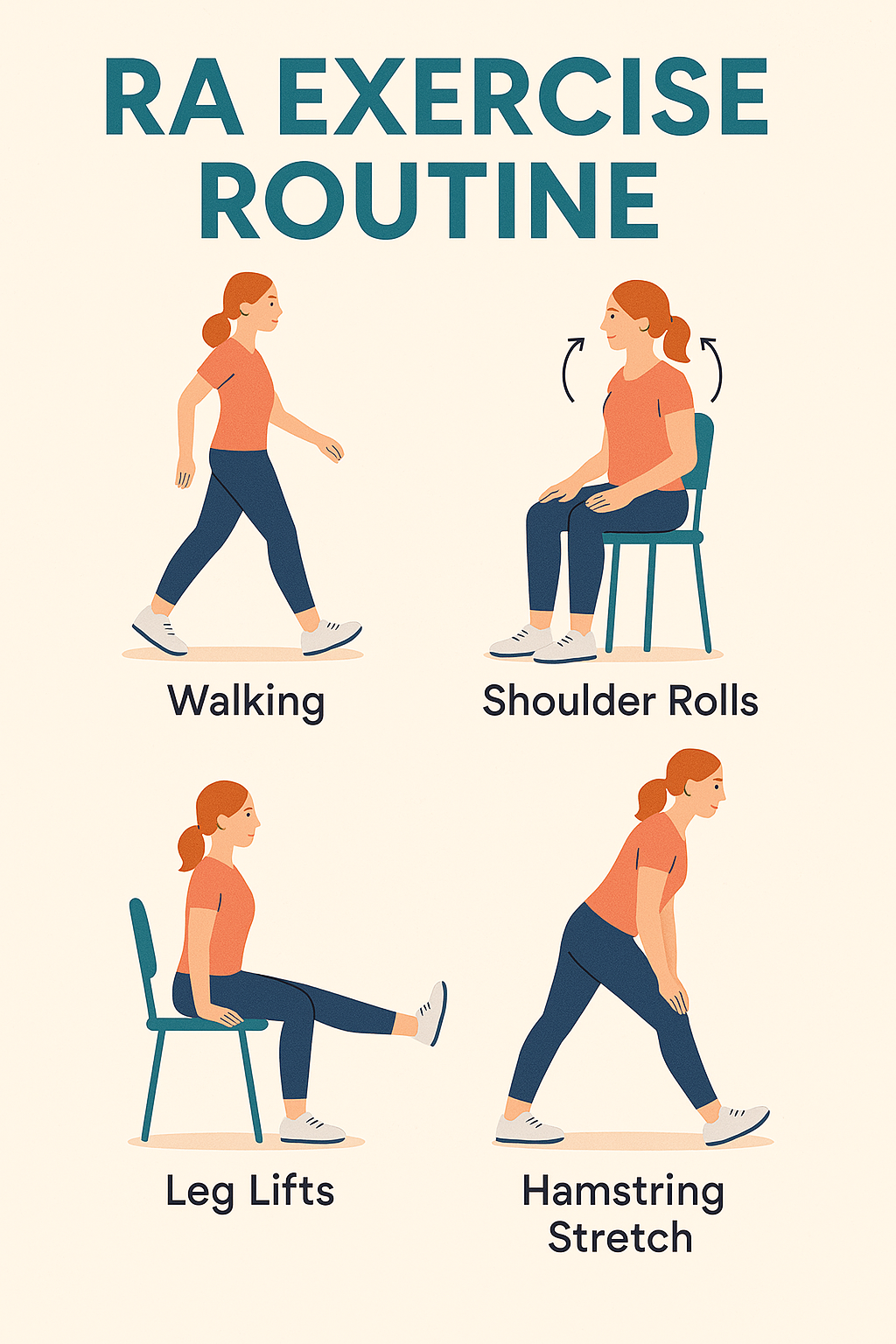Rheumatoid arthritis exercise routines Living with rheumatoid arthritis (RA) doesn’t mean you have to give up on physical activity. In fact, a consistent, RA-friendly workout routine can help reduce joint pain, improve flexibility, and ease morning stiffness. This guide outlines a daily RA exercise plan tailored to your comfort level, including low-impact exercises for arthritis, gentle stretching, and pain relief movements to support joint health.
Introduction: Why Rheumatoid Arthritis Exercise Matters for RA
Rheumatoid arthritis exercises (RA) is a chronic autoimmune disease that affects your joints, causing pain, stiffness, and fatigue. While it might seem like rest is the best solution, exercise is one of the most powerful tools to manage RA symptoms. And you should know about 25 High-Protein Snacks
The right Rheumatoid Arthritis exercise routine can:
- Reduce joint stiffness
- Improve flexibility
- Strengthen muscles
- Boost energy and mood
- Support healthy weight
Rheumatoid Arthritis Exercise: This step-by-step guide shows you how to build a safe, effective exercise routine tailored for RA.
Step-by-Step RA Rheumatoid Exercise Routine

Step 1: Get Cleared by Your Doctor
Before starting any exercise, speak with your rheumatologist or physical therapist. They can evaluate your joint condition and suggest modifications based on:
- Joint damage
- Flare status
- Medications
- Pain levels
Note: Never start high-impact workouts without medical approval.
Step 2: Warm Up Your Joints (5–10 Minutes)
Warming up prepares your joints and muscles, reducing your risk of injury. Go for gentle movements.
Warm-Up Exercises:
- Shoulder rolls: Roll your shoulders forward and backward (10x each)
- Neck tilts: Tilt your head side to side slowly
- Wrist circles: Rotate each wrist clockwise, then counterclockwise
- Ankle rolls: Do 10 circles in each direction
- March in place: Light marching to raise your heart rate
Tip: Use a heating pad before workouts if your joints are stiff in the morning.
Step 3: Do Low-Impact Aerobic Exercises (15–20 Minutes)
Aerobic or cardiovascular exercises help with endurance, energy, and overall heart health without stressing your joints.

RA-Friendly Cardio Options:
- Walking: Choose flat surfaces; wear cushioned shoes
- Stationary bike: No pressure on knees or hips
- Water aerobics or swimming: Eases joint pain through buoyancy
- Elliptical trainer: Smooth motion with low impact
Start with 10–15 minutes, gradually increase as your stamina improves.
Step 4: Strengthen Your Muscles (2–3 Times Per Week)
Stronger muscles support your joints and reduce strain. Use light resistance and focus on slow, controlled movements.
Strength Training Exercises:
- Wall push-ups: Stand 2 feet from a wall, push against it gently
- Seated leg lifts: Sit on a chair, straighten one leg at a time and hold
- Resistance bands: Use light bands for bicep curls, rows, or chest presses
- Grip exercises: Squeeze a soft ball to build hand strength
Reps: Start with 1 set of 8–10 reps, progress as you feel stronger
Rest: Take 48 hours between strength sessions for recovery
Step 5: Flexibility and Stretching Routine (Daily)
Flexibility exercises reduce stiffness and improve your range of motion. Always stretch after your workout or in the evening to ease tightness.
Stretching Exercises for RA:
- Hamstring stretch: Sit with one leg straight, lean forward gently
- Calf stretch: Stand facing a wall, press one foot back and stretch
- Wrist stretch: Extend one arm, use the other to pull fingers back gently
- Neck stretch: Tilt your head to one side, hold for 10–15 seconds
- Finger extensions: Open and close your hands slowly, 10 reps
Hold each stretch for 15–30 seconds, repeat 2–3 times.
Step 6: Balance and Coordination Exercises (2–3 Times Per Week)
Balance exercises help prevent falls and maintain joint stability—especially as RA may affect the knees or ankles.
Balance Routine:
- Heel-to-toe walk: Walk in a straight line placing heel to toe
- One-leg stand: Hold onto a chair and balance on one foot
- Tai Chi or yoga: Improves body awareness, calmness, and flexibility
These movements also reduce stress and improve posture.
Step 7: Cool Down and Deep Breathing (5–10 Minutes)
Cooling down gradually lowers your heart rate and relaxes your muscles.
Cool Down Tips:
- Walk slowly for 2–3 minutes
- Repeat light shoulder rolls or ankle circles
- Practice deep breathing: Inhale for 4 counts, exhale for 6
Finish your routine feeling calm and centered.
Rheumatoid Arthritis Exercise Weekly Schedule (Sample Plan)
| Day | Activity |
|---|---|
| Monday | Walking + Stretching |
| Tuesday | Strength + Balance + Stretching |
| Wednesday | Swimming or Yoga |
| Thursday | Strength Training + Stretching |
| Friday | Light Cardio + Balance |
| Saturday | Rest or Gentle Movement |
| Sunday | Flexibility + Deep Breathing |
Modify based on energy levels or flare-ups. Rest when needed.
Important RA Exercise Tips
- Listen to your body: Stop if a movement causes sharp pain.
- Avoid exercise during major flares: Use rest and gentle stretching.
- Stay consistent: Small steps every day build long-term results.
- Hydrate and fuel properly: Eat a balanced, anti-inflammatory diet.
- Track your progress: Use a fitness journal or app.
- Celebrate victories: Every walk, stretch, or movement counts!
An effective RA Rheumatoid Arthritis exercise routine is essential for managing rheumatoid arthritis symptoms like joint pain, stiffness, and fatigue. Low-impact exercises such as walking, swimming, stretching, and resistance training help improve flexibility, strengthen muscles, and support joint health without overstraining the body. A well-balanced RA workout plan includes cardio, strength training, flexibility exercises, and balance movements. Consistency and gentle progression are key, especially during remission periods. Always consult a healthcare provider before starting any new routine. With the right approach, an RA exercise routine can boost mobility, reduce inflammation, and enhance your overall quality of life. Movement truly is medicine.
Exercise for Joint Pain
Rheumatoid Arthritis Exercise for Joint Pain can be a powerful way to reduce stiffness, improve mobility, and strengthen the muscles around your joints. Gentle, low-impact movements are best, especially for conditions like arthritis or injury recovery. Ideal exercises include:
- Walking: Increases circulation and keeps joints flexible.
- Swimming or Water Aerobics: Relieves pressure while working muscles.
- Stretching: Eases stiffness and improves range of motion.
- Yoga or Tai Chi: Enhances balance, flexibility, and joint strength.
- Cycling (stationary bike): Boosts leg strength without joint strain.
Always warm up, go at your own pace, and consult a doctor if pain worsens.
10-Step Rheumatoid Arthritis Exercise Routine
1. Warm-Up for Arthritis Exercise (5–10 Minutes)
Begin with a gentle warm-up for arthritis exercise like neck rolls, shoulder shrugs, or ankle circles. These mobility exercises for arthritis help prepare your joints and reduce injury risk.
2. Low-Impact Cardio (10–15 Minutes)
Engage in low-impact exercise for arthritis such as walking, water aerobics, or cycling. These are excellent joint-friendly workouts that boost your heart health without straining your joints.
3. Range-of-Motion Exercises (5–10 Minutes)
Include range-of-motion exercises like arm swings, wrist rotations, or knee lifts. They help combat morning stiffnessand keep your joints moving comfortably.
4. Gentle Strength Training (2–3 Times a Week)
Incorporate resistance band workouts for arthritis or light dumbbells. Strength training for arthritis strengthens muscles around joints, improving stability and reducing pressure on inflamed areas.
5. Stretching for RA (Daily)
Daily stretching for RA is key to improving flexibility. Focus on slow, mindful stretches targeting your shoulders, wrists, hips, and knees.
6. Gentle Yoga for Joints (Optional 2–3x Weekly)
Practice gentle yoga for joints to relieve tension and improve posture. Yoga styles like Hatha or chair yoga are perfect anti-inflammatory exercises for RA sufferers.
7. Balance Exercises for RA (5 Minutes Daily)
Add balance exercises for RA like single-leg stands, heel-to-toe walks, or tai chi. These reduce the risk of falls and support coordination.
8. Breathing Techniques for Joint Pain (Daily)
Use breathing techniques for joint pain during cooldowns or flare-ups. Deep breathing reduces inflammation and calms the nervous system.
9. Flare-Up Safe Exercises
During flare-ups, focus on flare-up safe exercises like stretching in bed, gentle hand movements, or water therapy. Never force exercise during high pain days.
10. Cool Down & Rest
End with light stretches and breathing. Track how you feel and adjust your RA fitness routine based on your body’s response.
Sample Daily RA Exercise Plan
| Time | Activity |
|---|---|
| 9:00 AM | Warm-up + Stretching |
| 10:00 AM | Walking for RA management |
| Afternoon | Gentle yoga or resistance band workout |
| Evening | Breathing + cooldown stretch |
Tips for Success
- Choose joint-friendly workouts that feel good for your body.
- Start slow and build gradually.
- Use heat therapy before, and ice after if needed.
- Keep a journal to track progress and pain levels.
Final Thoughts: Movement is Medicine
Exercise is one of the best things you can do for RA. With a tailored routine, patience, and consistency, you can reduce pain, improve mobility, and feel more in control of your life.
You don’t need to run marathons or lift heavy weights—just keep moving. Every stretch, walk, and breath you take is a step toward living better with RA. exercise for joint pain
Is it safe to exercise with RA?
Yes—exercise helps reduce stiffness and builds strength. Just avoid high-impact workouts and listen to your body.
Should I exercise during a flare-up?
During mild flares, you can do gentle stretching. For severe flares, focus on rest and joint protection.
What exercise is best for rheumatoid arthritis?
Low-impact activities like walking, swimming, yoga, and resistance bands are best. Avoid anything that stresses inflamed joints.
Can exercise reverse joint damage in RA?
Exercise won’t reverse damage, but it prevents further deterioration, improves joint support, and boosts quality of life.
How often should I exercise with RA?
Aim for 30 minutes of movement most days. You can break it into 10-minute sessions if you’re tired.
